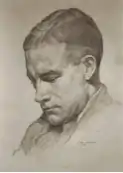Harold Burnell Carter | |
|---|---|
 Portrait of Carter as a young man c. 1930 | |
| Born | 3 January 1910 Mosman, New South Wales, Australia |
| Died | 27 February 2005 (aged 95) |
| Occupation | Veterinary scientist (sheep) |
| Known for | Scientific study of the merino wool follicle, scientific history of the Merino, the life and work of Sir Joseph Banks |
| Spouse | Mary (née Brandon Jones) |
| Children | 3, including Brandon Carter |
| Academic background | |
| Alma mater | School of Veterinary Science, University of Sydney |
Harold Burnell Carter, BVSc, DVSc (Hon), FRSE, AM; (3 January 1910 – 27 February 2005) was an Australian scientist whose work in the middle decades of the twentieth century at the CSIR (now CSIRO) – Australia's national scientific research organization – laid foundations for the scientific understanding of the biology of Merino fine wool – upon which much of Australia's economy depended at the time. As an author, he has been collected by libraries.[1]
Research
Carter's investigations were focussed upon the histology of the wool fibre, its embryonic development and the genetic and environmental factors that caused variability in wool quality. His aim was to establish the necessary scientific knowledge by which the economic value of the Merino could be improved. He was a strong supporter of women's participation in this research.[2] Burnell conceived the idea of an Australian national Sheep and Wool laboratory. In the early 1940s, he drafted a plan for such laboratories, which he developed in discussion with his senior colleagues Lionel B. Bull and Ian Clunies Ross.[3][4][5][6] In 1945, as part of Australia's post War economic development plan, an Act of the Australian Parliament was passed for their construction (Wool Uses Promotion Act, 1945).[3][4] The laboratories, built at Prospect Hill near Sydney under Carter's supervision, were opened in 1953 as the "Sheep Biology Laboratory" of the CSIRO (renamed the "Ian Clunies Ross Animal Research Laboratory" in 1959 following the death of Clunies Ross, the Director of CSIRO).[7]
Following completion of the Sheep Biology Laboratory, Carter resigned from the CSIRO and took a position at the Animal Breeding Research Organisation in Edinburgh, Scotland.[5]

In the later decades of his life he devoted himself increasingly to primary historical scientific research on the origins of the Merino as a producer of fine wool. This work culminated in a major biography of Sir Joseph Banks, a founder of Australia's Merino fine wool economy.[8]
Honours
- Fellow of the Royal Society of Edinburgh (1960)[9]
- Honorary Degree of Doctor of Veterinary Science, University of Sydney (1996)[10]
- Member of the Order of Australia (1999)[11]
Major publications
- H.B. Carter "The Development and General Histology of the Follicle Group in the skin of the Merino" C.S.I.R. (Australia) Bulletin No. 164, 1-21, 1943
- H.B. Carter "His Majesty’s Spanish Flock" Angus & Robertson Ltd, 1964
- H.B. Carter "Sir Joseph Banks, 1743-1820" British Museum (Natural History), 1988
Bibliography
- R. Carter "A review of the life, work and influences of Harold Burnell Carter, August 2013" Files of the Royal Society of Edinburgh
- H.B. Carter "Notes on the Development of Sheep and Wool Research in Australia 1934-1954" Files of the Royal Society of Edinburgh
- Brad Collis "Fields of Discovery: Australia’s CSIRO" (CSIRO Publishing) 2002
- Charles Massy "The Australian Merino" (Random House) 2007
- "Wool Uses Promotion Act" Parliament of the Commonwealth of Australia, 1945
- Marjory Collar O’Dea "Ian Clunies Ross a biography" (Hyland House, Melbourne) 1997
References
- ↑ "Carter, Harold B. (Burnell)". worldcat.org. Retrieved 27 November 2016.
- ↑ Carter, H. B. (2000). "A personal memoir of the Australian Merino: Australian sheep & wool research 1932–1954", retrieved 2017-07-04
- 1 2 "The Ian Clunies Ross Animal Research Laboratory, Prospect,New South Wales", Ian W. Macdonald, Nature, 1960, vol 187, no.4742, (1960) pgs 980-982
- 1 2 Minutes of Evidence to Parliamentary Standing Committee on Public Works, The Parliament of the Commonwealth of Australia [Monday 20th June and Saturday 25th June 1949] "Wool Biology Laboratory, Prospect, New South Wales" By Authority: L.F. Johnston, Commonwealth Government Printer, Canberra. F.3639
- 1 2 Massy, Charles; Ferguson, Ken (2007). "Forward". The Australian Merino: The Story of a Nation (2, illustrated, revised ed.). Random House Australia. pp. viii & ix. ISBN 978-1741666922.
- ↑ "Fields of Discovery: Australia’s CSIRO" by Brad Collis (CSIRO Publishing), 2002
- ↑ "The Ian Clunies Ross Animal Research Laboratory, Prospect, New South Wales" Ian W. McDonald, Nature, 1960, vol 187, no. 4742, pages 980 -982
- ↑ "Sir Joseph Banks" by Harold Burnell Carter (British Museum (Natural History), London) 1988
- ↑ "Dr Harold Burnell Carter FRSE". The Royal Society of Edinburgh. 28 October 2016. Retrieved 27 January 2019.
- ↑ "Mr Harold Burnell Carter" (PDF). The University of Sydney. 1 March 1996. Archived (PDF) from the original on 1 June 2021. Retrieved 1 June 2021.
- ↑ "Dr Harold Burnell Carter: Member of the Order of Australia (Award Extract)". honours.pmc.gov.au. 26 January 1999. Retrieved 26 March 2019.
Citation: for service to the wool industry, particularly the study of factors affecting wool growth, and for research into the life and work of Sir Joseph Banks. Yeo Bank, Congresbury, N. Somerset BS49 5JA UK. AM S16 1999